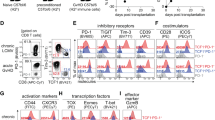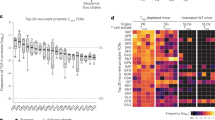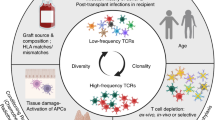Abstract
Acute graft-versus-host disease (GVHD) is a disorder involving the skin, gut and liver that is caused by mismatches of major and/or minor histocompatibility antigens between the HLA-identical donor and recipient. If T lymphocytes infiltrating GVHD lesions recognize antigens expressed in these organs, T cell clones should expand in inflammatory tissues. We previously reported that recipients of allogeneic bone marrow grafts have clonally expanded TCRαβ+ T lymphocytes soon after transplantation, which leads to a skew of TCR repertoires. To establish whether or not the same antigens cause clonal expansion of T lymphocytes in both blood and GVHD tissues, we examined the usage of TCR α and β chain variable regions (TCRAV and TCRBV) and determined the complementarity-determining region 3 (CDR3) of T lymphocytes clonally expanded in circulating blood and GVHD lesions. We found that the repertoires and CDR3 diversity of TCRAV and TCRBV differed between the GVHD lesions and circulating blood, suggesting the selective recruitment of antigen-specific T cells into GVHD tissues. We also found that the usage of TCRAV and TCRBV by the clonally expanded T lymphocytes and their CDR3 sequences differed between the GVHD tissues and blood. These results suggest that the antigen specificity of TCRαβ+ T lymphocytes clonally expanded in blood and GVHD lesions is different.
This is a preview of subscription content, access via your institution
Access options
Subscribe to this journal
Receive 12 print issues and online access
$259.00 per year
only $21.58 per issue
Buy this article
- Purchase on Springer Link
- Instant access to full article PDF
Prices may be subject to local taxes which are calculated during checkout




Similar content being viewed by others
References
Goulmy E . Human minor histocompatibility antigens: new concepts for marrow transplantation and adoptive immunotherapy Immunol Rev 1997 157: 125 140
Meadows L, Wang W, den Haan JM et al. The HLA-A*0201-restricted H-Y antigen contains a posttranslationally modified cystein that significantly affects T cell recognition Immunity 1997 6: 273 281
Perreault C, Decary F, Brochu S et al. Minor histocompatibility antigens Blood 1990 76: 1269 1280
Speiser DE, Zurcher T, Ramseier H et al. Nuclear myxovirus-related protein Mx is a minor histocompatibility antigen Proc Natl Acad Sci USA 1990 87: 2021 2025
Matsutani T, Yoshioka T, Tsuruta Y et al. Restricted usage of T cell receptor α-chain variable region (TCRAV) and T cell receptor β-chain variable region (TCRBV) repertoires after human allogeneic haematopoietic transplantation Br J Haematol 2000 109: 759 769
Hirokawa M, Matsutani T, Horiuchi T et al. Extensive clonal expansion of T lymphocytes causes contracted diversity of the complementarity-determining region 3 and a skewing of Tcell receptor repertoires after allogeneic hematopoietic cell transplantation Bone Marrow Transplant 2001 27: 607 614
Horiuchi T, Hirokawa M, Kawabata Y et al. Identification of the T cell clones expanding within both CD8+CD28+ and CD8+CD28− T cell subsets in recipients of allogeneic hematopoietic cell grafts and its implication in post-transplant skewing of T cell receptor repertoire Bone Marrow Transplant 2001 27: 731 739
Hirokawa M, Horiuchi T, Kawabata Y et al. Oligoclonal expansion of CD4+CD28- T lymphocytes in recipients of allogeneic hematopoietic cell grafts and identification of the same T cell clones within both CD4+CD28+ and CD4+CD28− T cell subsets Bone Marrow Transplant 2001 27: 1095 1100
Effros RB, Pawelec G . Replicative senescence of T cells: does the Hayflick Limit lead to immune exhaustion? Immunol Today 1997 18: 450 454
Globerson A, Effros RB . Ageing of lymphocytes and lymphocytes in the aged Immunol Today 2000 21: 515 520
Fink PJ, Matis LA, McElligott DL et al. Correlation between T cell specificity and the structure of the antigen receptor Nature 1986 321: 219 226
Moss PA, Moots RJ, Rosenberg WM et al. Extensive conservation of α and β chains of the human T cell antigen receptor recognizing HLA-A2 and influenza A matrix peptide Proc Natl Acad Sci USA 1991 88: 8987 8990
Argaet VP, Schmidt CW, Burrows SR et al. Dominant selection of an invariant T cell antigen receptor in response to persistent infection by Epstein–Barr virus J Exp Med 1994 180: 2335 2440
Wither J, Pawling J, Phillips L et al. Amino acid residues in the T cell receptor CDR3 determine the antigenic reactivity patterns of insulin-reactive hybridomas J Immunol 1991 146: 3513 3522
Bowness P, Moss PA, Rowland-Jones S et al. Conservation of T cell receptor usage by HLA B27-restricted influenza-specific cytotoxic T lymphocytes suggests a general pattern for antigen-specific major histocompatibility complex class I-restricted responses Eur J Immunol 1993 23: 1417 1421
Davis MM, Bjorkman PJ . T cell antigen receptor genes and T cell recognition Nature 1988 334: 395 402
McHeyzer-Williams MG, Davis MM . Antigen-specific development of primary and memory T cells in vivo Science 1995 268: 106 111
Storb R, Deeg HJ, Whitehead J et al. Methotrexate and cyclosporine compared with cyclosporine alone for prophylaxis of acute graft versus host disease after marrow transplantation for leukemia New Engl J Med 1986 314: 729 735
Glucksberg H, Storb R, Fefer A et al. Clinical manifestations of graft-versus-host disease in human recipients of marrow from HLA-matched sibling donors Transplantation 1974 18: 295 304
Matsutani T, Yoshioka T, Tsuruta Y et al. Analysis of TVRAV and TCRBV repertoires in healthy individuals by microplate hybridization assay Hum Immunol 1997 56: 57 69
Yoshioka T, Matsutani T, Iwagami S et al. Polyclonal expansion of TCRBV2- and TCRBV6-bearing T cells in patients with Kawasaki disease Immunology 1999 96: 465 472
Yamamura M, Uyemura K, Deans RJ et al. Defining protective responses to pathogens: cytokine profiles in leprosy lesions Science 1991 254: 277 279
Tsuruta Y, Iwagami S, Furue S et al. Detection of human T cell receptor cDNAs (α, β, γ and δ) by ligation of a universal adaptor to variable region J Immunol Methods 1993 161: 7 12
Pannetier C, Even J, Kourilsky P . T cell repertoire diversity and clonal expansions in normal and clinical samples Immunol Today 1995 16: 176 181
Kitabayashi A, Hirokawa M, Hatano Y et al. Granulocytecolony-stimulating factor down-regulates allogeneic immune responses by post-transcriptional inhibition of tumor necrosis factor-α production Blood 1995 86: 2220 2227
Kawabata Y, Hirokawa M, Kitabayashi A et al. Defective apoptotic signal transduction pathway downstream of caspase-3 in human B-lymphoma cells: a novel mechanism of nuclear apoptosis resistance Blood 1999 94: 3523 3530
Hirokawa M, Horiuchi T, Kitabayashi A et al. Delayed recovery of CDR3 complexity of the T cell receptor β chain in recipients of allogeneic bone marrow transplants who had virus-associated interstitial pneumonia: monitor of T cell function by CDR3 spectratyping J Allergy Clin Immunol 2000 106: 32 39
Kubo K, Yamanaka K, Kiyoi H et al. Different T cell receptor repertoires between lesions and peripheral blood in acute graft-versus-host disease after allogeneic bone marrow transplantation Blood 1996 87: 3019 3026
Liu X, Chesnokova V, Forman SJ, Diamond DJ . Molecular analysis of T cell receptor repertoire in bone marrow transplant recipients: evidence for oligoclonal T cell expansion in graft-versus-host disease lesions Blood 1996 87: 3032 3044
Gorochov G, Debre P, Leblond V et al. Oligoclonal expansion of CD8+CD57+ T cells with restricted T cell receptor β chain variability after bone marrow transplantation Blood 1994 83: 587 595
Masuko K, Kato S, Hagihara M et al. Stable clonal expansion of T cells induced by bone marrow transplantation Blood 1996 87: 789 799
den Haan JM, Meadows LM, Wang W et al. The minor histocompatibility antigen HA-1: a diallelic gene with a single amino acid polymorphism Science 1998 279: 1054 1057
Goulmy E, Schipper R, Pool J et al. Mismatches of minor histocompatibility antigens between HLA-identical donors and recipients and development of graft-versus-host disease after bone marrow transplantation New Engl J Med 1996 334: 281 285
Lim A, Trautmann L, Peyrat M-A et al. Frequent contribution of T cell clonotypes with public TCR features to the chronic response against a dominant EBV-derived epitope: application to direct detection of their molecular imprint on the human peripheral T cell repertoire J Immunol 2000 165: 2001 2011
Dolstra H, Fredrix H, Preijers F et al. Recognition of a B cell leukemia-associated minor histocompatibility antigen by CTL J Immunol 1997 158: 560 565
Collins RH Jr, Shpilberg O, Drobyski WR et al. Donor leukocyte infusions in 140 patients with relapsed malignancy after allogeneic bone marrow transplantation J Clin Oncol 1997 15: 433 444
Yoshioka T, Matsutani T, Iwagami S et al. Quantitative analysis of the usage of human T cell receptor α and β chain variable regions by reverse dot blot hybridization J. Immunol. Methods 1997 201: 145 155
Concannon P, Robinson MA . Human T cell receptor gene nomenclature Ann NY Acad Sci 1995 756: 124 129
Acknowledgements
We thank Dr Setsuya Ohtani for performing diagnostic colonofiberscopic examinations. This work was supported by grants from the Ministry of Education, Science, Sports and Culture of Japan (08670508, 10670932 and 14570960), the Yamashita Taro-Kensho Memorial Foundation and the Uehara Memorial Foundation.
Author information
Authors and Affiliations
Rights and permissions
About this article
Cite this article
Hirokawa, M., Matsutani, T., Saitoh, H. et al. Distinct TCRAV and TCRBV repertoire and CDR3 sequence of T lymphocytes clonally expanded in blood and GVHD lesions after human allogeneic bone marrow transplantation. Bone Marrow Transplant 30, 915–923 (2002). https://doi.org/10.1038/sj.bmt.1703730
Received:
Accepted:
Published:
Issue Date:
DOI: https://doi.org/10.1038/sj.bmt.1703730
Keywords
This article is cited by
-
Potential of TCR sequencing in graft-versus-host disease
Bone Marrow Transplantation (2023)
-
Accumulation of autoreactive effector T cells and allo-specific regulatory T cells in the pancreas allograft of a type 1 diabetic recipient
Diabetologia (2009)
-
The presence and longevity of peripherally expanded donor-derived TCRαβ+ mature T lymphocyte clones after allogeneic bone marrow transplantation for adult myeloid leukemias
Leukemia (2003)



